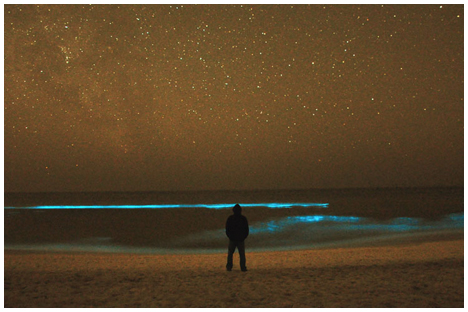
Algae creates glowing phenomena
Local resident and photographer August Bach captured this incredible photo of bioluminescent algae “glowing” along the wave crests recently at Grayton Beach.
Bioluminescence an amazing natural phenomena that occurs when a type of planktonic algae (microscopic free-floating algae) has high densities of excess nutrients. The glow appears when the algae is disturbed by motion.
To learn more about August Bach go to his website at www.augustbach.com
Bioluminescence explained
Steven Haddock, Ph.D.
Scientist
Bioluminescence and Zooplankton
Monterey Bay Aquarium Research Institute
Bioluminescence is one of the most amazing natural phenomenons because it seems to be drawn from science fiction or comic books, rather than science and natural history. Where else to you find characters with green lanterns, or shooting red beams of light, or escaping with a flash of blue light. How can a living animal make light? The technical answer is that light is produced by energy released from chemical reactions occurring inside (or ejected by) an organism.
One would think that this capability would be rare in nature, yet in the ocean most types of animals — ranging from bacteria to sharks — include bioluminescent members. In fact, it is estimated that luminescence has evolved independently at least 40 times. The functions of bioluminescence are not known for all animals, but typically it is used during ecological interactions for defense (warning or evading predators) or offense (luring or detecting prey), and at times for communication between members of the same species.
In addition to spanning the range of marine diversity, bioluminescence is also found throughout marine habitats, from the surface to the deep sea floor. It remains difficult to study however, because organisms must be captured in good condition to witness their bioluminescent behavior. Nets and grab-type samplers are too indiscriminate to obtain healthy specimens from the deep ocean floor a kilometer below the surface. As a result, the properties and extent of bioluminescence in deep sea corals and associated deep reef communities is very poorly known.
The optical “cousin” of bioluminescence is the phenomenon of fluorescence. In fluorescent compounds, energy from one color (wavelength) of light is converted to another color. Fluorescence is often associated with bioluminescence because (1) bioluminescent chemicals can sometimes fluoresce, and (2) fluorescent proteins can be chemically linked to the light-emitting bioluminescent chemicals. Why is fluorescence important? It’s important because it gives a way for organisms living in a monochromatic environment (blue light from the surface or bioluminescence itself) a way to appear colorful and to tailor the visual signals that they are presenting.
Information courtesy noaa.gov

swiss420
November 7, 2010As Children, I and my brothers witnessed this phenomenon first hand in Port de la Selva, Spain. The whole bay seemed to light up with every wave disturbing the Water. Swirling a Stick around in the Water made a nice trail of light. We bottled up some of the Water and for a couple of days we were able to keep the bioluminescent state when shacking it. Unfortunately we did not have a Camera to take a picture but It was very impressive to experience this.